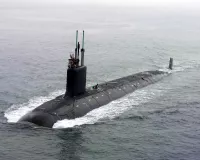The Indian Navy is the maritime branch of the Indian Armed Forces, with the President of India as the Supreme Commander. Commanded by the Chief of Naval Staff, a four-star admiral, it functions as a blue-water navy. It operates in key regions like the Persian Gulf, the Horn of Africa, and the Strait of Malacca, focusing on anti-piracy operations with allied navies. The Indian Navy also undertakes routine deployments in the South and East China Seas, as well as the western Mediterranean Sea.
1928: First Indian commissioned in the Royal Indian Marine
In 1928, D. N. Mukherji became the first Indian to be granted a commission in the Royal Indian Marine, holding the rank of an Engineer Sub-lieutenant. Also in 1928, the RIM was accorded combatant status.
1934: Royal Indian Marine upgraded to Royal Indian Navy
In 1934, the Royal Indian Marine (RIM) was upgraded to a full naval force, becoming the Royal Indian Navy (RIN), and was presented with the King's colours in recognition of its services to the British Crown.
June 1940: Doubling of the navy's strength
By June 1940, the Royal Indian Navy had doubled its number in terms of both personnel and material due to the onset of World War II.
1942: Royal Indian Navy expansion
By 1942, the Royal Indian Navy had expanded to nearly six times its pre-war strength due to the ongoing World War II.
February 1945: Commissioning of HMIS Shivaji
In February 1945, HMIS Shivaji was commissioned. It currently serves as the premier Technical Training Establishment (TTE) of the Indian Navy as INS Shivaji.
August 1945: Royal Indian Navy demobilization
In August 1945, with the cessation of hostilities of World War II, the Royal Indian Navy underwent a rapid, large-scale demobilisation of vessels and personnel.
1945: Navy remained a predominantly British-officered service
Even by the war's end in 1945, the Navy remained a predominantly British-officered service; in 1945, no Indian officer held a rank above engineer commander and only a few Indian officers in the executive branch held substantive senior line officer rank.
1946: Royal Indian Navy mutiny
In 1946, the Royal Indian Navy mutiny was ignited by Indian ratings due to various factors, including the degree of "Indianisation" of the Navy, subordination to the Royal Navy, inadequate training, racial discrimination, and the ongoing trials of ex-Indian National Army personnel. A total of 78 ships, 20 shore establishments and 20,000 sailors were involved in the strike.
July 1947: First Indian RIN officers attain acting rank of captain
On July 21, 1947, H.M.S. Choudhry and Bhaskar Sadashiv Soman became the first Indian RIN officers to attain the acting rank of captain.
January 1948: First Indian officer promoted acting engineer captain
In January 1948, D.N. Mukherji, the first Indian officer in the RIN, became the first Indian to be promoted to the acting rank of engineer captain.
May 1948: First Indian officer appointed to the rank of commodore
In May 1948, Captain Ajitendu Chakraverti became the first Indian officer to be appointed to the rank of commodore.
1948: Admiral Sir Edward Parry took over as C-in-C
In 1948, Admiral Sir Edward Parry took over from Hall as Commander-in-Chief (C-in-C) of the Navy.
1948: Establishment of Directorate of Naval Aviation
In early 1948, the Directorate of Naval Aviation was established at Naval Headquarters (NHQ), marking the beginning of naval aviation in India. Officers and sailors were subsequently sent to Britain for pilot training.
January 1950: Renaming to Indian Navy
On January 26, 1950, when India became a republic, the Royal prefix was dropped, and the name 'Indian Navy' was officially adopted, along with changes to naval vessel prefixes and insignia.
1950: Adoption of Modified British White Ensign
From 1950, the Indian Navy used a modified version of the British White Ensign, with the Union flag replaced by the Indian Tricolour.
1951: Admiral Sir Charles Thomas Mark Pizey took over as C-in-C
In 1951, Admiral Sir Charles Thomas Mark Pizey took over from Admiral Sir Edward Parry as Commander-in-Chief (C-in-C) of the Navy.
1951: Formation of Fleet Requirement Unit
In 1951, the Fleet Requirement Unit (FRU) was formed to address the aviation requirements of the Indian Navy.
1952: Senior Naval appointments filled by Indian officers
By 1952, senior Naval appointments had begun to be filled by Indian officers, marking a significant step in the 'Indianising' of the Navy.
January 1953: Navy takes over Cochin Airfield
On January 1, 1953, the Indian Navy assumed control of Cochin airfield from the Directorate General of Civil Aviation.
October 1953: First President's Fleet Review
On 10 October 1953, India hosted its first President's fleet review, conducted by President Rajendra Prasad, marking a significant event in the navy's history.
February 1955: Acquisition of Firefly Aircraft
From February 1955 to December 1958, the Indian Navy acquired ten Firefly aircraft to enhance its capabilities.
1955: Overcoming post-Independence personnel shortfalls
By 1955, the Navy had largely overcome its post-Independence personnel shortfalls.
1955: Admiral Pizey became the first Chief of the Naval Staff
In 1955, Admiral Pizey became the first Chief of the Naval Staff. Basic training for naval cadets was entirely conducted in India.
April 1958: First Indian Chief of Staff
On April 22, 1958, Vice Admiral Ram Dass Katari assumed command of the Indian Navy from Carlill as the first Indian Chief of Staff of the Indian Navy.
December 1958: Acquisition of Firefly Aircraft
From February 1955 to December 1958, the Indian Navy acquired ten Firefly aircraft to enhance its capabilities.
January 1959: Commissioning of INAS 550
On January 17, 1959, the FRU was commissioned as Indian Naval Air Squadron (INAS) 550, becoming the first Indian naval air squadron.
November 1961: Portuguese troops fired on the passenger liner Sabarmati
On 21 November 1961, Portuguese troops fired on the passenger liner Sabarmati near Anjadip Island, killing one person and injuring another.
1962: Defensive role in the Sino-Indian War
In 1962, during the Sino-Indian War, the Indian Navy had only a defensive role as the war was largely fought over the Himalayas.
1962: Indian Navy becomes an entirely Indian service
In 1962, with the departure of the last British officer, Commodore David Kirke, the Indian Navy finally became an entirely Indian service.
1965: First Successful Expedition to Mount Everest
In 1965, Lt. Cdr. M. S. Kohli led the Indian Navy's first successful expedition to Mount Everest, marking a significant achievement.
1965: Indo-Pakistani War of 1965
In 1965, at the outbreak of the Indo-Pakistani War, the Indian Navy had one aircraft carrier, two cruisers, nineteen destroyers and frigates, and one tanker. During the war, the Pakistani Navy attacked the Indian coastal city of Dwarka. Following the war, India resolved to strengthen its Armed Forces.
December 1971: Indo-Pakistani War of 1971
In December 1971, during the Indo-Pakistani War, under the command of Admiral Sardarilal Mathradas Nanda, the Indian Navy successfully enforced a naval blockade of West and East Pakistan. On 4 December, the Indian Navy successfully executed Operation Trident, a devastating attack on the Pakistan Naval Headquarters of Karachi that sank a minesweeper, a destroyer and an ammunition supply ship. The attack also irreparably damaged another destroyer and oil storage tanks at the Karachi port. 4 December is celebrated as the Navy Day.
1981: First Naval Ensign in Antarctica
In 1981, the Indian Naval ensign first flew in Antarctica, signifying the Navy's presence in polar regions.
1983: Operation Lal Dora
In 1983, the Indian Navy planned for Operation Lal Dora to support the government of Mauritius against a feared coup.
1986: Operation Flowers are Blooming
In 1986, in Operation Flowers are Blooming, the Indian Navy averted an attempted coup in the Seychelles.
1987: Raising of the Marine Commando Force (MARCOS)
In 1987, the Indian Navy raised the Marine Commando Force (MCF), also known as MARCOS, as a special operations unit specializing in various types of warfare and operations.
October 1999: Rescue of MV Alondra Rainbow
In October 1999, the Indian Navy, along with the Indian Coast Guard, rescued MV Alondra Rainbow, a pirated Japanese cargo ship.
February 2001: International Fleet Review: Bridges of Friendship
In February 2001, the Indian Navy conducted an International Fleet Review named Bridges of Friendship in Mumbai, with participation from ships of friendly navies worldwide, including two from the US Navy.
2001: Establishment of Andaman and Nicobar Command
In 2001, the Andaman and Nicobar Command, a unified Indian Navy, Indian Army, Indian Air Force, and Indian Coast Guard theater command, was established in the Andaman and Nicobar Islands, with its base at Port Blair.
2001: Replacement of the Naval Ensign
In 2001, the modified British White Ensign was replaced with a white ensign bearing the Indian Navy crest, as the previous ensign was thought to reflect India's colonial past.
2001: Reference to Previous Ensign Design
The new ensign revealed in September 2022 retains much of the design of the 2001-04 ensign.
January 2003: INS Tarangini began circumnavigating the world
On 23 January 2003, the sailing ship and training vessel INS Tarangini began circumnavigating the world, with the intention of fostering good relations with various other nations.
2003: Naval Exercise with People's Liberation Army Navy
In 2003, the Indian Navy conducted a naval exercise with the People's Liberation Army Navy, marking a step in military cooperation.
May 2004: Return of INS Tarangini from circumnavigation
In May 2004, INS Tarangini returned to India after visiting 36 ports in 18 nations, completing its circumnavigation of the world which started in January 2003.
May 2004: Navy's Ensign Flown atop Everest
On 19 May 2004, the Navy's ensign was flown atop Mount Everest by an Indian Navy expedition, continuing the tradition of naval achievements in mountaineering. The expedition was led by Cdr Satyabrata Dam.
2004: Indian Ocean earthquake and tsunami relief operations
In 2004, following the Indian Ocean earthquake and tsunami, the Indian Navy launched massive disaster relief operations to aid affected Indian states, as well as Maldives, Sri Lanka, and Indonesia. The operations included Operation Madad in Andhra Pradesh and Tamil Nadu, Operation Sea Waves in the Andaman and Nicobar Islands, Operation Castor in Maldives, Operation Rainbow in Sri Lanka and Operation Gambhir in Indonesia. Over 27 ships, dozens of helicopters, at least six fixed-wing aircraft and over 5000 personnel were deployed in relief operations.
2004: Publication of INBR 8
In 2004, the INBR 8 edition of the Indian Maritime Doctrine was published amidst a larger strategic overhaul, emphasizing key themes such as transition to a blue-water navy and acquisitions of nuclear submarines and aircraft carriers.
2004: Change Back to St. George's Cross Design
In 2004, the ensign was changed back to the St. George's cross design, with the addition of the emblem of India in the intersection of the cross, after complaints that the new ensign was indistinguishable.
2004: First Edition of Indian Maritime Doctrine Published
In 2004, the first edition of the Indian Maritime Doctrine was published (INBR 8) amidst a larger strategic overhaul in the country. It contains a large number of key words along with their definitions and grouped into a number of sections.
May 2005: Commissioning of INS Kadamba at Karwar
In May 2005, the Indian Navy commissioned INS Kadamba at Karwar as an exclusively Navy controlled base without sharing port facilities with commercial shipping under the first phase of Project Seabird.
2005: TROPEX (Theatre-level Readiness Operational Exercises)
In 2005, TROPEX (Theatre-level Readiness Operational Exercises) was held, during which Indian Navy experimented with the doctrine of influencing a land and air battle to support the Indian Army and the Indian Air Force.
July 2006: Operation Sukoon during the 2006 Israel-Lebanon conflict
In July 2006, during the Israel-Lebanon conflict, the Indian Navy initiated Operation Sukoon and successfully evacuated 2,280 individuals, including 436 Sri Lankans, 69 Nepalese, and 7 Lebanese nationals, from war-torn Lebanon between July 20 and 29.
2006: Mission Dakshin Dhruv 2006
In 2006, the Indian Navy succeeded in Mission Dakshin Dhruv 2006 by traversing to the South Pole on skis, setting the record for being the first military team to have successfully completed a ski traverse to the Geographic South Pole.
2007: First Indian Ocean Naval Symposium (IONS)
In 2007, India held the first Indian Ocean Naval Symposium (IONS) to provide a forum for littoral nations of the Indian Ocean to cooperate on security matters.
2007: Naval Exercises and Agreements
In 2007, the Indian Navy conducted naval exercises with the Japan Maritime Self-Defence Force and the U.S. Navy in the Pacific, and also conducted naval exercises with Vietnam, Philippines, and New Zealand. India and South Korea conducted an annual naval exercise, alongside India's participation in the South Korean International Fleet Review in 2008.
2007: Relief operations for Cyclone Sidr survivors in Bangladesh
In 2007, the Indian Navy provided support for relief operations aimed at assisting the survivors of Cyclone Sidr in Bangladesh.
2007: Freedom to Use the Seas Published
In 2007, the naval strategy Freedom to Use the Seas was published as a foundational document.
October 2008: Continuous warship deployment in Gulf of Aden
Since October 2008, the Indian Navy has maintained at least one frontline warship continuously deployed in the Gulf of Aden to deter threats and promote maritime security.
2008: International Relief Operations for Cyclone Nargis victims and deployment to combat piracy
In 2008, Indian Naval vessels were the first to launch international relief operations for victims of Cyclone Nargis in Myanmar. Additionally, the navy deployed INS Tabar and INS Mysore into the Gulf of Aden to combat piracy in Somalia, preventing numerous piracy attempts and escorting hundreds of ships safely. The navy also undertook anti-piracy patrols near the Seychelles, upon that country's request.
July 2009: INS Arihant Launched
In July 2009, INS Arihant was launched in Visakhapatnam. Arihant is the first of the Arihant-class nuclear-powered ballistic missile submarines and the first nuclear-powered submarine built in India.
2009: Update to Include Counter-Terror and Counter-Piracy
In 2009, the Indian Maritime Doctrine edition was updated to include counter-terror, counter-piracy, and coordination with other navies in these aspects.
2009: Establishment of the Indian Naval Academy
In 2009, the Indian Naval Academy (INA) was established at Ezhimala, on the coast of Kerala. It is the largest naval academy in Asia.
2009: First Atlantic Ocean Deployment
In 2009, the Indian Navy had its first Atlantic Ocean deployment. During this deployment, the Indian Naval fleet conducted exercises with the French, German, Russian and British navies.
2009: Mission Navy Documentary Series
In 2009, the National Geographic Channel created and broadcast a documentary series on the Indian Navy titled Mission Navy.
2009: Second Edition of Indian Maritime Doctrine Published
In 2009, the second edition of the Indian Maritime Doctrine was published.
May 2010: First Solo Circumnavigation by an Indian Citizen
On 22 May 2010, Cdr. Dilip Donde completed the first solo circumnavigation by an Indian citizen, marking a historic achievement.
February 2011: Operation Safe Homecoming in Libya
In February 2011, the Indian Navy launched Operation Safe Homecoming and rescued Indian nationals from war-torn Libya.
November 2011: Launch of Multi-Role Support Vessel
In November 2011, the Defence Acquisition Council launched the Multi-Role Support Vessel project. The Indian Navy subsequently sent out an international RFP for up to 2 large landing helicopter docks.
2011: International Fleet Review
In 2011, one of the two International fleet reviews took place.
2012: Initial Submarine Acquisition Target
By 2012, the initial plan was to induct the first 12 submarines (6 Project 75 and 6 Project 75I) as part of modernizing India's submarine fleet.
August 2013: Launch of GSAT-7 Satellite
In August 2013, India's first exclusive defence satellite, GSAT-7, was successfully launched by Arianespace's rocket from Kourou spaceport in French Guiana. GSAT-7 was fabricated by ISRO to serve for at least seven years, providing UHF, S-band, C-band and Ku-band relay capacity.
2014: Modification of Ensign and Naval Crest
In 2014, the ensign and the naval crest were further modified to include the Devanagari script: सत्यमेव जयते (Satyameva Jayate).
2014: Third Edition of Indian Maritime Doctrine Published
In 2014, the third edition of the Indian Maritime Doctrine was published.
August 2015: Indian Navy Classified as Rank 3 Navy
As of August 2015, the Indian Navy is classified as a Rank 3 navy (Power projection to regions adjacent to its own) on the Todd-Lindberg navy classification system of naval strength.
2015: Operation Raahat during the crisis in Yemen
During the 2015 crisis in Yemen, the Indian Navy participated in Operation Raahat, rescuing 3074 individuals, including 1291 foreign nationals.
2015: Ensuring Secure Seas Published
In 2015, an updated edition of the naval strategy, Ensuring Secure Seas, was published as a foundational document.
2015: Revision of Submarine Acquisition Plan
In 2015, the initial plan to acquire 24 conventionally powered attack submarines was revised. The planned numbers then stood at 4 SSBNs, 6 SSNs and 18 conventionally powered attack submarines.
February 2016: International Fleet Review 2016
In February 2016, the International Fleet Review 2016 was held off Visakhapatnam coast, with a focus on improving diplomatic relations and military compatibility with other nations.
April 2016: Poseidon-8I thwarts piracy attack
On April 15, 2016, a Poseidon-8I long-range patrol aircraft successfully thwarted a piracy attack on the high seas by flying over MV Sezai Selaha, a merchant vessel, which was being targeted by a pirate mother ship and two skiffs around 800 nautical miles from Mumbai.
August 2016: INS Arihant Secretly Commissioned
In August 2016, INS Arihant was secretly commissioned into active service.
2016: TROPEX Not Conducted
In 2016, TROPEX was not conducted, marking an exception to the annual exercise.
2016: International Fleet Review
In 2016, one of the two International fleet reviews took place.
2017: Commemoration of 50 Years of Navy's First Everest Expedition
In 2017, to commemorate 50 years of the Navy's first expedition in 1965, a team set off to climb Mount Everest.
June 2019: Order Placed for GSAT-7R Satellite
On 15 June 2019, the Indian Navy placed an order for GSAT-7R satellite as a replacement for GSAT-7. The satellite costs Rs 1589 crores (US$225.5 million).
June 2019: Navy Personnel Strength
As of 1 June 2019, the Indian Navy comprised 10,012 officers and 57,240 sailors, against a sanctioned strength of 11,557 officers and 74,046 sailors, inclusive of personnel from Naval Air Arm, Marine Commando Force, and Sagar Prahari Bal.
2020: Planned Fleet Size and Responsibilities
By the end of the 14th Plan (2020), the Indian Navy was expected to have over 150 ships and close to 500 aircraft. It was also tasked with responding to emergencies far away from the Indian mainland, and enhancing marine assault capabilities.
2020: Expected Launch of GSAT-7R Satellite
In 2020, the GSAT-7R satellite was expected to be launched as a replacement for GSAT-7.
2021: Assistance in US-led Exercise Cutlass Express
In 2021, India assisted in the US-led Exercise Cutlass Express as a trainer, contributing to international maritime security efforts.
February 2022: Latest Fleet Review Held
In February 2022, the latest fleet review was held at Visakhapatnam, by President Ram Nath Kovind, continuing the tradition of presidential inspections of the fleet.
May 2022: Appointment of First Navy MCPO
On 1 May 2022, the Indian Navy appointed Rajendra Kumar Behera as the first Navy MCPO.
August 2022: Announcement of New Naval Ensign
In August 2022, the Prime Minister's Office announced that the naval ensign featuring the Saint George's Cross would be irrevocably disposed of, in favor of a newer design.
September 2022: Indian Navy operational fleet composition
As of September 2022, the operational fleet of the Indian Navy consisted of 2 active aircraft carriers, 1 amphibious transport dock, 4 landing ship tanks, 8 landing craft utility, 14 destroyers, 14 frigates, 2 ballistic missile submarines, 16 conventionally-powered attack submarines, 18 corvettes, 1 mine countermeasure vessel, 4 fleet tankers and numerous other auxiliary vessels, small patrol boats and sophisticated ships.
September 2022: Reveal of New Ensign and Commissioning of INS Vikrant
In September 2022, the new ensign was revealed by prime minister Narendra Modi, coinciding with the commissioning ceremony of INS Vikrant, the Indian Navy's first indigenously built aircraft carrier. The new ensign retains much the design of the 2001-04 ensign with the national flag as the canton, but with the addition of an octagonal navy blue shield based on Shivaji's royal seal.
September 2022: Commissioning of INS Vikrant
On September 2, 2022, the indigenously built INS Vikrant, a second aircraft carrier, was commissioned into the Indian Navy.
May 2023: Indian Navy Fleet Composition
As of May 2023, the Indian Navy's surface fleet consists of a mix of domestic and foreign-built vessels, including 2 aircraft carriers, 1 amphibious transport dock, 7 landing ship tanks, 13 destroyers, 13 frigates, 20 corvettes, 10 large offshore patrol vessels, 4 fleet tankers, 7 Survey ships, 1 research vessel, 3 training vessels, and auxiliary vessels, Landing Craft Utility vessels, and small patrol boats.
January 2024: Operation Sankalp Deployment and Prevention of Hijacking
In January 2024, the Indian Navy deployed over 10 warships under Operation Sankalp to protect commercial shipping in the Gulf of Aden and the Arabian Sea due to Houthi-led attacks. The INS Chennai prevented the hijacking of the Liberian merchant vessel MV Lila Norfolk on January 5. While India declined to join Operation Prosperity Guardian, it coordinated with the US, UK, and France.
February 2024: Approval of Project 75 Alpha Submarines
On 18 February 2024, the Indian Government approved the clearance for Project 75 Alpha submarines, marking a significant step in the modernization of the Indian Navy's submarine fleet.
May 2024: Replacement of Naval Terms
In May 2024, the Indian Navy officially replaced the terms "Jack" and "Jackstaff" with "National Flag" and "National Flag Staff" due to the British Royal Navy's traditions. This implies the short pole on the bow of the ship to host the flag in naval parlance.
August 2024: Navy's Planned Submarine Acquisitions
As of August 2024, the Indian Navy's planned acquisitions of submarines include 4 SSBNs, 6 SSNs, and 18 conventionally powered attack submarines, reflecting a revised plan for modernizing its submarine fleet.
August 2024: Indian Navy's Sub-Surface Fleet
As of August 2024, the Indian Navy's sub-surface fleet comprises three Arihant-class SSBN and 16 conventionally-powered attack submarines, including five Kalvari, seven Sindhughosh, and four Shishumar classes.
2024: Impact of the Maritime Anti-Piracy Act and commitment to combating piracy
In 2024, Chief Admiral R. Hari Kumar acknowledged the Maritime Anti-Piracy Act as a "great enabler" in the navy's anti-piracy efforts. Also in 2024, The Economic Times highlighted the Indian Navy's "unwavering" commitment to combating maritime piracy.
2024: Autonomous Vessel Transit Demonstration
In 2024, Sagar Defence Engineering Pvt Ltd demonstrated 850 nautical mile autonomous transit of, Matangi Autonomous Surface Vessel to the Indian Navy. This demonstration was part of Indian Navy's Swavalamban 2024 self reliance in technology contest to enable the development of autonomous vessels for various military applications.
2030: Planned Induction of Project 76 Submarines
The initial plan included the induction of the next 12 indigenous Project 76 submarines by 2030 as part of modernizing India's submarine fleet.
Mentioned in this timeline

A submarine is a watercraft capable of independent operation underwater...
New Zealand is an island country located in the southwestern...
India officially the Republic of India is a South Asian...
Myanmar also known as Burma is a Southeast Asian country...
World War II - was a global conflict between the...
Japan is an East Asian island country situated in the...
Trending

6 months ago Sarah Sherman's SNL Checks Mistakenly Sent to Gilda Radner's Estate: A Sobbing Revelation

Lily Allen is an English singer songwriter and actress known for her distinctive voice and candid lyrics She gained prominence...

8 days ago Jesse Plemons discusses 'Bugonia', Oscar buzz, and career from child actor.

2 months ago Tyrese Haliburton Opens Up About Achilles Injury Grief, Impacting Pacers' Season Start

Simon Cowell is a prominent English television personality and businessman recognized for his role as a judge on various talent...

7 months ago Gary Payton Reflects on Jordan Matchup and Hypothetical Stats in Today's NBA
Popular

Candace Owens is an American conservative political commentator and author...

Ilhan Omar is an American politician currently serving as the...

XXXTentacion born Jahseh Dwayne Ricardo Onfroy was a controversial yet...

Tom Cotton is an American politician and Army veteran currently...
The Kennedy Center Honors are annual awards recognizing individuals and...

Kelsey Grammer is an accomplished American actor producer and singer...